1995 OLDSMOBILE SILHOUETTE light
[x] Cancel search: lightPage 171 of 390
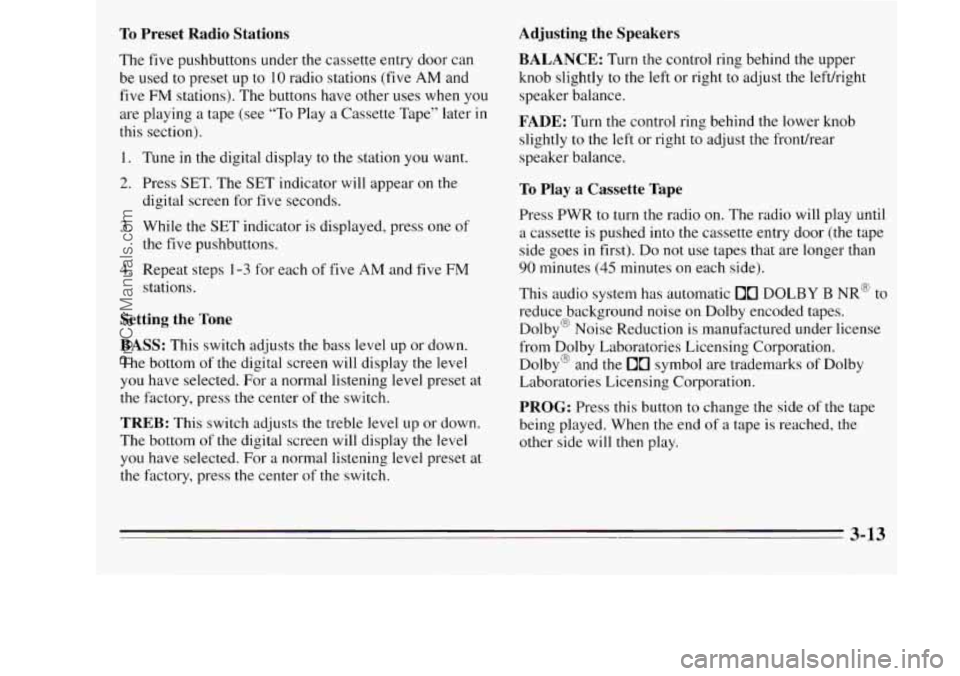
To Preset Radio Stations
The five pushbuttons under the cassette entry door can
be used
to preset up to 10 radio stations (five AM and
five
FM stations). The buttons have other uses when you
are playing a tape (see “To Play
a Cassette Tape” later in
this section).
1. Tune
in the digital display to the station you want.
2. Press SET. The SET indicator will appear on the
digital screen for five seconds.
3. While the SET indicator is displayed, press one of
4. Repeat steps 1-3 for each of five AM and five FM
the five pushbuttons.
stations.
Setting the Tone
BASS: This switch adjusts the bass level up or down.
The bottom of the digital screen will display the level
you have selected. For
a normal listening level preset at
the factory, press the center
of the switch.
TREB: This switch adjusts the treble level up or down.
The bottom of the digital screen will display
the level
you have selected. For a normal listening level preset at
the factory, press the center of the switch.
Adjusting the Speakers
BALANCE:
Turn the control ring behind the upper
knob slightly to the left or right to adjust the leftlright
speaker balance.
FADE: Turn the control ring behind the lower knob
slightly to the left or right
to adjust the fronthear
speaker balance.
To Play a Cassette Tape
Press PWR to turn the radio on. The radio will play until
a cassette is pushed into the cassette entry door (the tape
side goes in first). Do not use tapes that are longer than
90 minutes (45 minutes on each side).
This audio system has automatic
00 DOLBY B NR@ to
reduce background noise on Dolby encoded tapes.
Dolby@ Noise Reduction is manufactured under license
from Dolby Laboratories Licensing Corporation.
Dolby@ and the
00 symbol are trademarks of Dolby
Laboratories Licensing Corporation.
PROG: Press this button to change the side of the tape
being played. When the end of
a tape is reached, the
other side will
then play.
3-13
ProCarManuals.com
Page 172 of 390
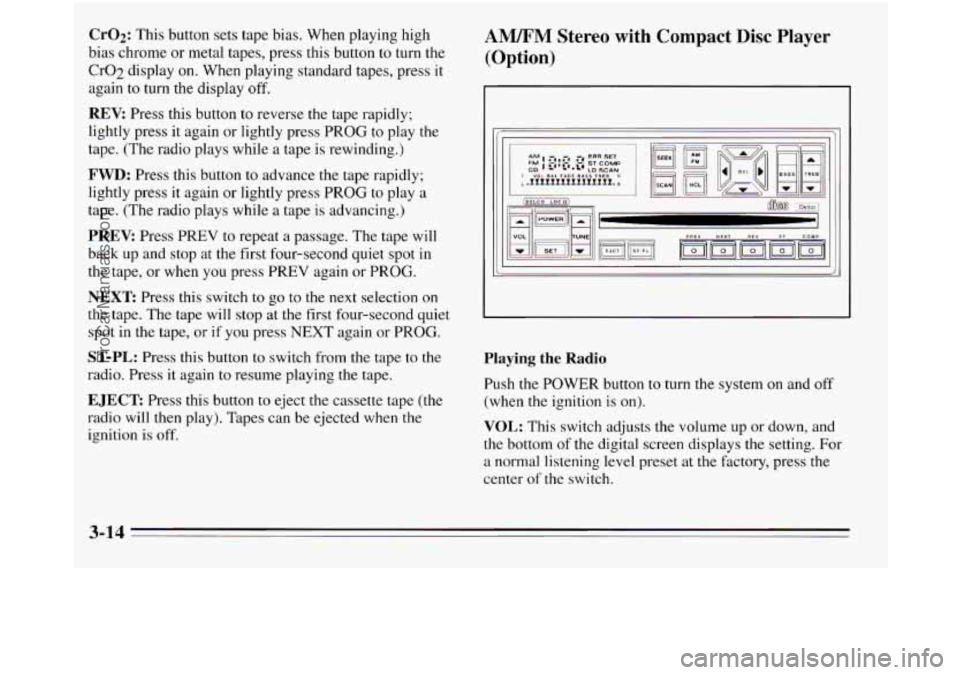
Cr02: This button sets tape bias. When playing high
bias chrome or metal tapes, press this button to turn the
Cr02 display
on. When playing standard tapes, press it
again to turn the display
off.
REV: Press this button to reverse the tape rapidly;
lightly press it again or lightly press PROG to play the
tape. (The radio plays while
a tape is rewinding.)
FWD: Press this button to advance the tape rapidly;
lightly press it again or lightly press PROG to play a
tape. (The radio plays while a tape is advancing.)
PREV: Press PREV to repeat a passage. The tape will
back
up and stop at the first four-second quiet spot in
the tape,
or when you press PREV again or PROG.
NEXT Press this switch to go to the next selection on
the tape. The tape will stop at the first four-second quiet
spot in the tape,
or if you press NEXT again or PROG.
ST-PL: Press this button to switch from the tape to the
radio. Press it again to resume playing the tape.
EJECT Press this button to eject the cassette tape (the
radio will then play). Tapes can be ejected
when the
ignition is off.
AM/FM Stereo with Compact Disc Player
(Option)
Playing the Radio
Push the POWER button to turn the system on and off
(when the ignition is on).
VOL: This switch adjusts the volume up or down, and
the bottom of the digital screen displays the setting. For
a normal listening level preset at the factory, press the
center
of the switch.
3-14
ProCarManuals.com
Page 179 of 390

adjusting the volume control on your radio to a safe
sound level before your hearing adapts to
it.
To help avoid hearing loss or damage:
1. Adjust the volume control
to the lowest setting.
2. Increase the volume slowly until you can hear
comfortably and clearly.
I NOTICE:
Before you add any sound equipment to your
vehicle
-- like a tape player, CB radio, mobile
telephone or two-way radio
-- be sure you can
add what you want.
If you can, it’s very
important to do it properly. Added sound equipment may interfere with the operation of
your vehicle’s engine, Delco@ radio
or other
systems, and even damage them. And, your
vehicle’s systems may interfere with the
operation
of sound equipment that has been
added improperly.
Before adding sound equipment, check with your retailer and be sure to check Federal rules
covering mobile radio and telephone units.
Understanding Radio Reception
FM Stereo
FM stereo will give you the best sound, but FM signals
will reach
only about 10 to 40 miles ( 16 to 65 km). Tall
buildings or hills can interfere with
FM signals, causing
the sound
to come and go.
AM The range for most AM stations is greater than for
FM,
especially at night. The longer range, however, can
cause stations to interfere with each other. AM can
also
pick up noise from things like storms and power lines.
To lower this noise, try reducing the treble level.
AM Stereo
Your Delco@ system may be able
to receive C-Quam@
stereo broadcasts. Many AM stations around the country
use C-Quam@
to produce stereo, though some do not.
C-Quam@ is a registered trademark of Motorola, Inc. If
your Delco@ system can get C-Quam@ signals, your
stereo indicator light will come on when
you are
receiving
it.
3-21
ProCarManuals.com
Page 180 of 390
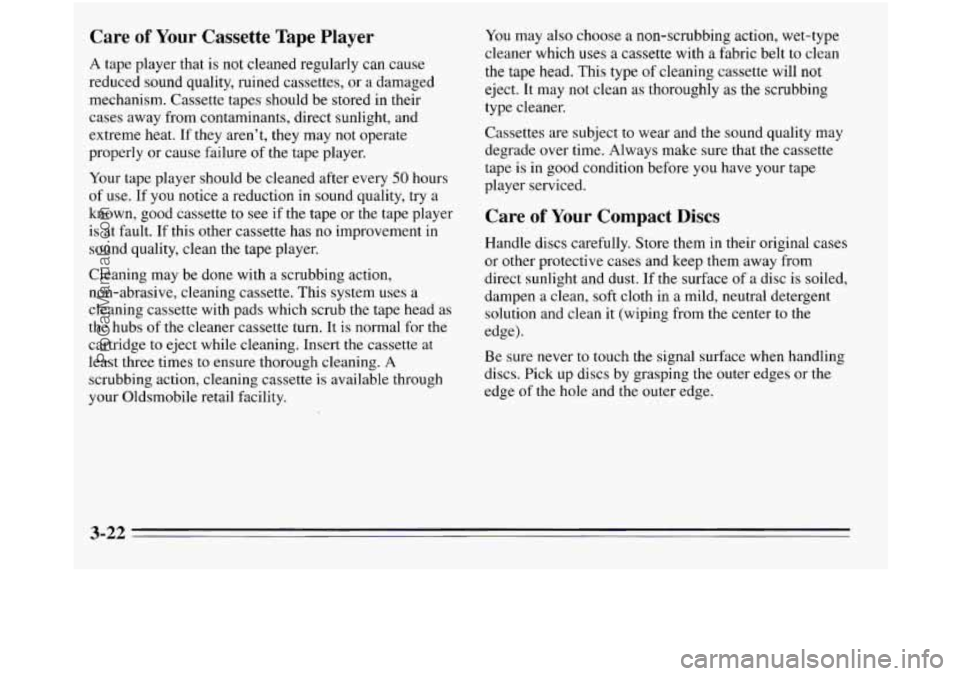
Care of Your Cassette Tape Player
A tape player that is not cleaned regularly can cause
reduced sound quality, ruined cassettes,
or a damaged
mechanism. Cassette tapes should be stored in their
cases away from contaminants, direct sunlight, and
extreme heat. If they aren’t, they may not operate
properly or cause failure of the tape player.
Your tape player should be cleaned after every 50 hours
of use. If you notice a reduction in sound quality, try a
known, good cassette to see if the tape or the tape player
is at fault.
If this other cassette has no improvement in
sound quality, clean the tape player.
Cleaning may be done with a scrubbing action,
non-abrasive, cleaning cassette. This system uses a
cleaning cassette with pads which scrub the tape head as
the hubs of the cleaner cassette turn. It
is normal for the
cartridge to eject while cleaning. Insert the cassette at
least three times to ensure thorough cleaning. A
scrubbing action, cleaning cassette
is available through
your Oldsmobile retail facility. You
may also choose
a non-scrubbing action, wet-type
cleaner which uses a cassette with a fabric belt to clean
the tape head. This type of cleaning cassette will not
eject. It may not clean as thoroughly
as the scrubbing
type cleaner.
Cassettes are subject to wear and the sound quality may
degrade over time. Always make sure that
the cassette
tape is in good condition before you have your tape
player serviced.
Care of Your Compact Discs
Handle discs carefully. Store them in their original cases
or other protective cases and keep them away from
direct sunlight and dust. If the surface
of a disc is soiled,
dampen a clean, soft cloth in a mild, neutral detergent
solution and clean it (wiping from the center to the
edge).
Be sure never to touch the signal surface when handling
discs. Pick up discs by grasping the outer edges or the
edge
of the hole and the outer edge.
3-22
~
ProCarManuals.com
Page 189 of 390
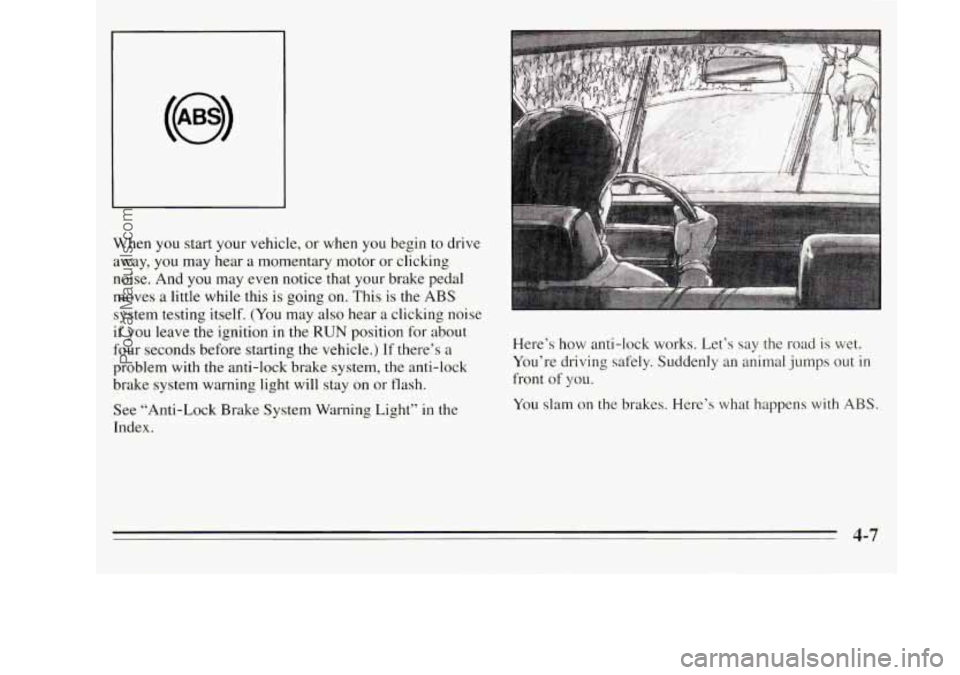
When you start your vehicle, or when you begin to drive
away, you may hear
a momentary motor or clicking
noise. And
you may even notice that your brake pedal I
moves a little while this is going on. This is the ABS
system testing itself. (You may also hear a clicking noise
if you leave the ignition in the
RUN position for about
four seconds before starting the vehicle.) If there’s
a
problem with the anti-lock brake system, the anti-lock
brake system warning light will stay on or flash.
See “Anti-Lock Brake System Warning Light’’ in the
Index. Here’s
how anti-lock works. Let’s say the road
is wet.
You’re driving safely. Suddenly an animal jumps out
in
front of you.
You slam on the brakes. Here’s what happens with
ABS.
4-7
ProCarManuals.com
Page 190 of 390
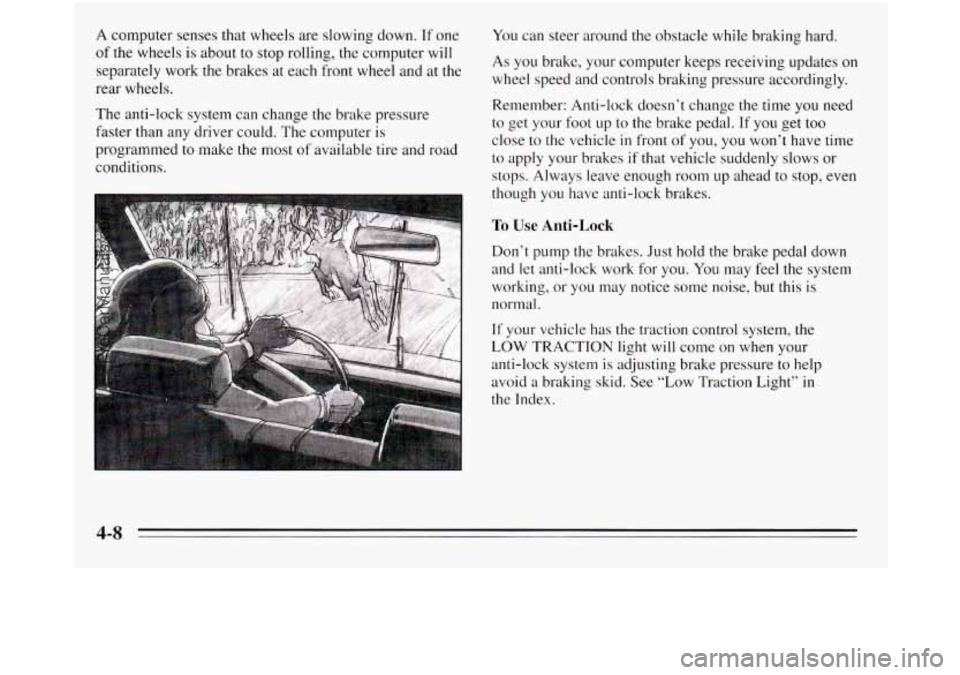
A computer senses that wheels are slowing down. If one
of the wheels is about to stop rolling, the computer will
separately work the brakes at each front wheel and at the
rear wheels.
The anti-lock system can change
the brake pressure
faster than any driver could. The computer
is
programmed to make the most of available tire and road
conditions.
You can steer around the obstacle while braking hard.
As you brake, your computer keeps receiving updates on
wheel speed and controls braking pressure accordingly.
Remember: Anti-lock doesn’t change the time you need
to get your foot up to the brake pedal. If you get too
close
to the vehicle in front of you, you won’t have time
to apply your brakes if that vehicle suddenly slows or
stops. Always leave enough room up ahead
to stop, even
though you have anti-lock brakes.
To Use Anti-Lock
Don’t pump the brakes. Just hold the brake pedal down
and let anti-lock work for you.
You may feel the system
working, or you may notice some noise, but this
is
normal.
If your vehicle has the traction control system, the
LOW TRACTION light will come on when your
anti-lock system
is adjusting brake pressure to help
avoid a braking skid. See “Low Traction Light” in
the Index.
4-8
ProCarManuals.com
Page 191 of 390
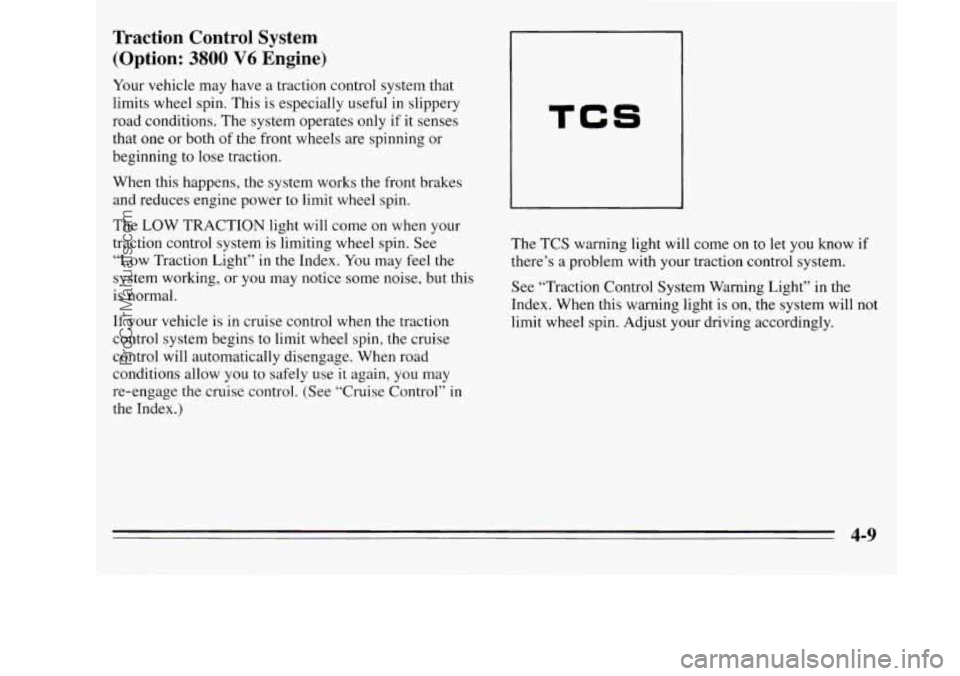
Traction Control System
(Option:
3800 V6 Engine)
Your vehicle may have a traction control system that
limits wheel spin. This is especially useful in slippery
road conditions. The system operates only if it senses
that one or both of the front wheels are spinning or
beginning to lose traction.
When this happens, the system works the front brakes
and reduces engine power to limit wheel spin.
The LOW TRACTION light will come on when your
traction control system is limiting wheel spin. See
“Low Traction Light” in the Index. You may feel the
system working, or you may notice some noise, but this
is normal.
If your vehicle is in cruise control when the traction
control system begins to limit wheel spin, the cruise
control will automatically disengage. When road
conditions allow you
to safely use it again, you may
re-engage the cruise control. (See “Cruise Control” in
the Index.)
TCS
The TCS warning light will come on to let you know if
there’s a problem with your traction control system.
See “Traction Control System Warning Light’’ in the
Index. When this warning light is on, the system will not
limit wheel spin. Adjust your driving accordingly.
4-9
ProCarManuals.com
Page 192 of 390
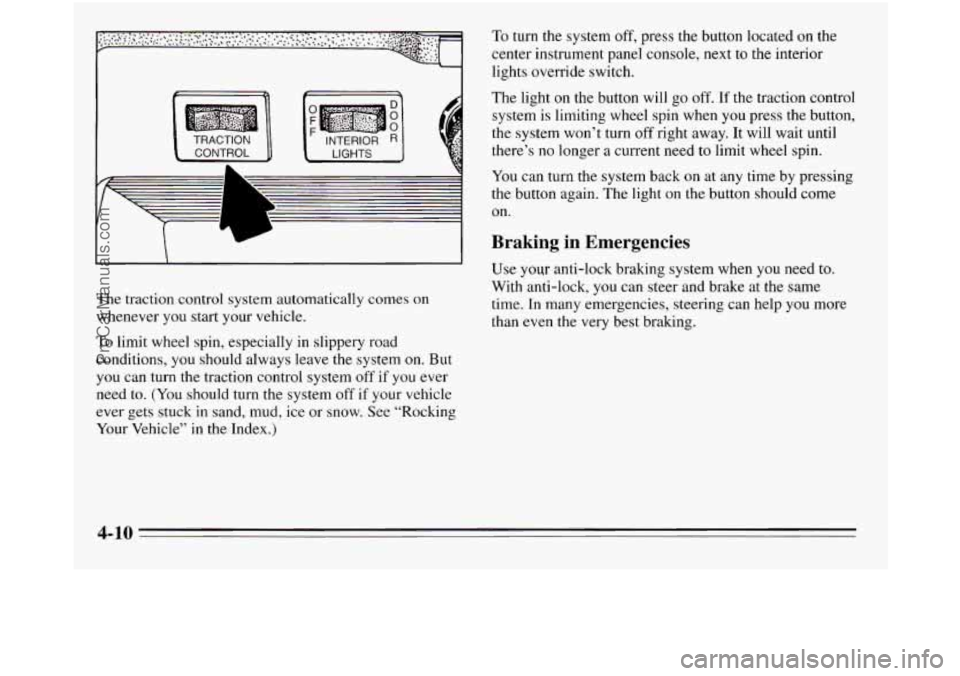
The light on the button will go off. If the traction control
system is limiting wheel spin when you press the button,
the system won’t turn
off right away. It will wait until
there’s no longer a current need to limit wheel spin.
You can turn the system back on at any time by pressing
the button again. The light on the button should come
on.
Braking in Emergencies
I I I Use your anti-lock braking system when you need to.
With anti-lock,
you can steer and brake at the same
time. In many emergencies, steering can help you more
than even the very best braking.
The
traction control system automatically comes
on
whenever you start your vehicle.
To limit wheel spin, especially in slippery road
conditions,
you should always leave the system on. But
you can turn the traction control system off if you ever
need to.
(You should turn the system off if your vehicle
ever gets stuck
in sand, mud, ice or snow. See “Rocking
Your Vehicle” in the Index.)
4-10
ProCarManuals.com